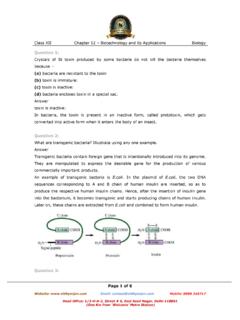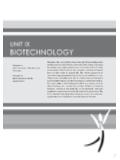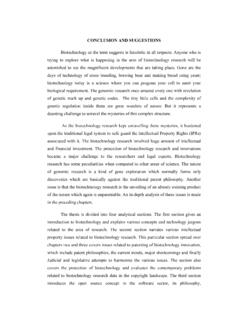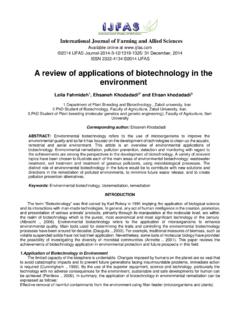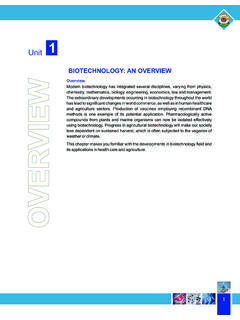Transcription of Biotechnology, Biodiversity, and Sustainable Agriculture ...
1 biotechnology , biodiversity , and Sustainable Agriculture : A Contradiction? R. B. Singh1 This paper describes (1) the status of the use of biotechnology for conservation and utilization of biodiversity and interaction among them, (2) the status of use of biotechnology for Sustainable Agriculture , (3) how real are the contradictions among biotechnology , biodiversity and Sustainable Agriculture , (4) issues and efforts in resolving the concerns and contradictions, and (5) the way ahead. The author cited that it is not the science of biotechnology which is a subject of controversy, but the mode and nature of its applications , through techniques and technologies which could stir controversies.
2 biotechnology contributes to Sustainable Agriculture by reducing dependence on agro-chemicals, particularly pesticides, through the deployment of genes conferring resistance or tolerance to biotic and abiotic stresses. Discussing some concerns about risks posed by some aspects of biotechnology , the author stressed that the contradictions and risks surrounding the development and applications of biotechnology should be resolved scientifically and transparently for which individual countries should have the necessary research, technology assessment, impact monitoring, technology refinement, and adjustment capacities.
3 Introduction The Convention on Biological Diversity (CBD) defined biotechnology as any technology application that uses biological systems, living organisms, or derivatives there of, to make or modify products or processes for specific use. In a broad sense, the definition covers many of the tools and techniques, which have been commonly used in Agriculture and food production, processing, and utilization. In a narrow sense, however, it encompasses DNA techniques, molecular biology, and reproductive technological applications dealing primarily with gene splicing and recombination, and genomics.
4 In the present context, the narrow sense definition of biotechnology has been considered. biotechnology is already underpinning the Sustainable development of Agriculture , forestry, and fisheries, as well as the food and other primary product- related industries. It has tremendous potential for impacting global food security, human and animal health, environmental health, and overall livelihood of mankind (Serageldin 1999). However, as in the case of any complex technology impacting wide range of processes and developments, the gains from modern biotechnology are accompanied with certain negative effects and concerns.
5 The nature and extent of the positive and negative impacts will depend on the choice of the technique, place and mode of application of the technique, ultimate use of the product, concerned policies and regulatory measures, including risk assessment and management ability, and finally on the need, priority, aspiration and capacity of individual countries. What is applicable for 1 Assistant Director-General and Regional Representative, Asia and the Pacific Region, Food & Agriculture Organization (FAO) Bangkok, Thailand commercial commodities in USA, Europe, and Japan may not be true for food-deficit low-income and other developing countries.
6 We must know whose priorities ad agenda are we pursuing. Science is always truth seeking, beautiful, and caring. The science of biotechnology is no exception. Molecular biology researches have beautifully been disentangling the thread of life which are being carefully rearranged to serve the humanity by thwarting diseases, poverty, and hunger. It is the application part of the science which, at times, generates contradictions, and not the science per se. Modern biotechnology includes the following interdependent components: genomics, bioinformatics, transformation, molecular breeding, diagnostics, and vaccine technology.
7 While there is general appreciation of the potential and impact of each of the components, controversies generally surround the transformation component resulting in Genetically Modified Organisms (GMOs), which may pose certain risks inherent to the technology. Other contradictions, socioeconomic in nature, are technology-transcending (Leisinger 2000). Therefore, it is not the science of biotechnology which is a subject of controversy, but it is the mode and nature of its application, through techniques and technologies, which could stir contradictions.
8 biotechnology , especially as it deals with living organisms, with its veritable manifestations, has been a subject of extensive public debate. As regards biotechnology in relation to biodiversity and Sustainable Agriculture , the three are complementary, synergistic and interdependent, and not contradictory to each other. biodiversity is fundamental to both biotechnology and Sustainable Agriculture . Judicious, rational, and science- and need-based exploitation of genetic resources through biotechnological techniques should lead to Sustainable Agriculture .
9 The controversy arises only when non-scientific, hasty, profit-motivated, inhuman and unethical applications of biotechnology , and use of biodiversity are contemplated. Scares like terminator gene and the negative application of gene use restriction technologies (GURTs) are seen as moves toward monopolistic control of the thread of life by a few global companies. It has to be pointed out that the issues of food safety and biosafety could be matters of real contradiction. Horizontal gene transfer through genetic engineering is a possibility, posing threat to biodiversity and sustainability.
10 However, with the scientific assessment of the risk and adoption of preventive and corrective measures, the risks (contradictions) could be avoided or at least minimized. With the overwhelming evidence of high synteny among genomes of highly diverse organisms, such as flies and mammals, the risk from horizontal gene transfer gets diluted. As new results and understandings build up, which is happening exponentially, the risks and contradictions must be assessed critically and continually on a case-to-case basis.










